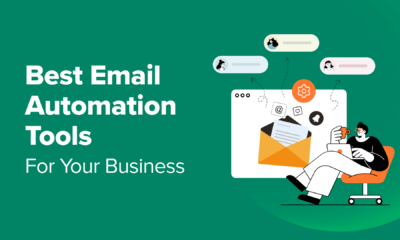After a long career in publishing that included stints at Harper’s Bazaar and as Yahoo’s Food editor in chief, Kerry Diamond, founder and editor in chief of Cherry Bombe, opened a restaurant. “I had never worked in restaurants, but I’d done everything related to books and magazines and newspapers,” said Diamond.”
“Publishing was my world, but the restaurant really opened my eyes. I realized women’s stories weren’t being told or prioritized in the industry. I was learning about all these incredible women and I wanted to help tell their stories. I had this idea to do a magazine called Cherry Bombe. I spent about a year working on it and it came out in May 2013.”
In 2013, Cherry Bombe launched as a print magazine. They needed to start their email list — and build their online presence — from scratch. At the time, they were hindered by a clunky email marketing platform that made it difficult to customize messaging and nearly impossible to align the brand’s aesthetic which was inspired by a rich history of beautifully designed print magazines.
They also needed to take more ownership of their content and communication strategy which was largely built on Instagram. They migrated to Mailchimp in 2014 for the ease-of-use, template options, and the ability to easily market products and track revenue through campaigns. But the secret sauce to their highly engaged email list lies in Cherry Bombe’s compelling, consistent content — stuff that readers are eager to receive in their inboxes.
The platform has helped them crystallize their brand’s look and messaging even while audience outreach and engagement remained focused on Instagram. During and after the pandemic, Cherry Bombe knew they needed to take more ownership of their messaging and audience outreach by focusing — and recalibrating — their email marketing approach.
It was Instagram first
Back then, Cherry Bombe didn’t have an email strategy. They were a brand that had built itself on Instagram. Diamond’s team was using the platform to communicate with its audience. Emails were just a supplement to the social media presence.
“We had a really great Instagram community and we were making a lot of our announcements via Instagram,” explained Diamond. “In the early part the pandemic, I started to notice changes to Instagram that troubled me. I noticed brands just weren’t growing the same way on Instagram. TikTok was starting to take a lot of attention away from Instagram and as much as I love Instagram, I knew we needed to control our communications with our audience.”
What’s old is new again
For Diamond, who had her roots in traditional publishing and understood the value of well-crafted and beautiful content, email seemed like the best way to take control of Cherry Bombe’s messaging. She’d been working with Mailchimp since 2014 and with a list of nearly 25,000 subscribers, Cherry Bombe had the tools in place to take control of their messaging.
“The obvious answer was Mailchimp,” said Diamond. Founded in 2011, Mailchimp is an email marketing platform with a reputation for being user friendly and affordable. When Cherry Bombe decided to refocus on using email to connect with their members, they used the platform to redesign their weekly emails which are sent out every Friday.

Said Diamond, “We wanted to keep it simple and beautifully designed. It was great because our email list grew, but it also stabilized.”
Cherry Bombe saw less churn with their newly designed email approach. They also got more serious about tracking results and paying attention to what worked in terms of things like subject line and send times. “We love the AB testing and we discovered some funny things like fewer people opened our emails when they had emojis in the subject line,” said Diamond.
By linking Mailchimp to their Shopify account, Cherry Bombe were able to monitor what drove subscriptions and other purchases on their website. They regularly track email performance including opens, clicks, and actions so they can further refine their email marketing approach and better understand their members.
Using email for profitability and entertainment
Cherry Bombe has two main goals when they send out emails — to be profitable and to entertain their members. These goals aren’t mutually exclusive. An entertaining email is an email that gets read and shared. It also motivates users to visit Cherry Bombe’s website to purchase from their online shop which sells issues of the magazine, the Cherry Bombe Cookbook, and gift cards.
Said Diamond, “I want to entertain people, you know, I want to make people smile when they get this email. Cherry Bombe is a very celebratory organization. I want people to open the email because they find something interesting or learn something.”
Cherry Bombe’s email strategy is a thoughtful one. They send out Friday emails to their paid subscribers, announce events like their annual Cherry Bombe Jubilee conference, and send occasional new product announcements.
Diamond is cautious about flooding subscriber inboxes with too much email. So far, this strategy is working — improving open and click rates and reducing member churn. In the future, Diamond wants to diversify email content and create more segmented messaging.
“I would love to do a handful of emails about product launches among people in our community. There’s a real trend right now of launching products, especially among young women of color, and I’d love to do a newsletter about everything that is happening in the CPG space in the food world. But I’m weighing it carefully because I don’t ever want us to get to the point where it’s too much, so I’d rather we take our time and be thoughtful about that.”
Think about the emails that are actually opened
Diamond advises businesses to think about the emails that people open (and read). This is the best way to reduce churn and offer value.
“It’s almost a crime today to put out a boring email. If you’re doing that, then you really need to rethink everything. Put yourself in the email recipient’s shoes and think about why you open emails and what makes you smile or act. Then put that into practice. If you can learn how to follow and trust your gut, you’re 99% of the way there as an entrepreneur,” said Diamond.





















You must be logged in to post a comment Login